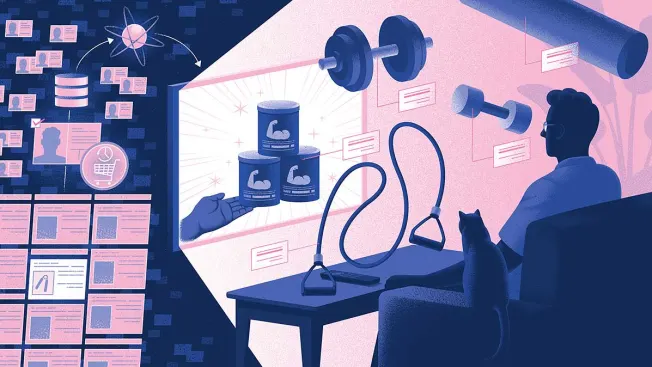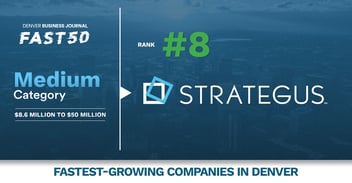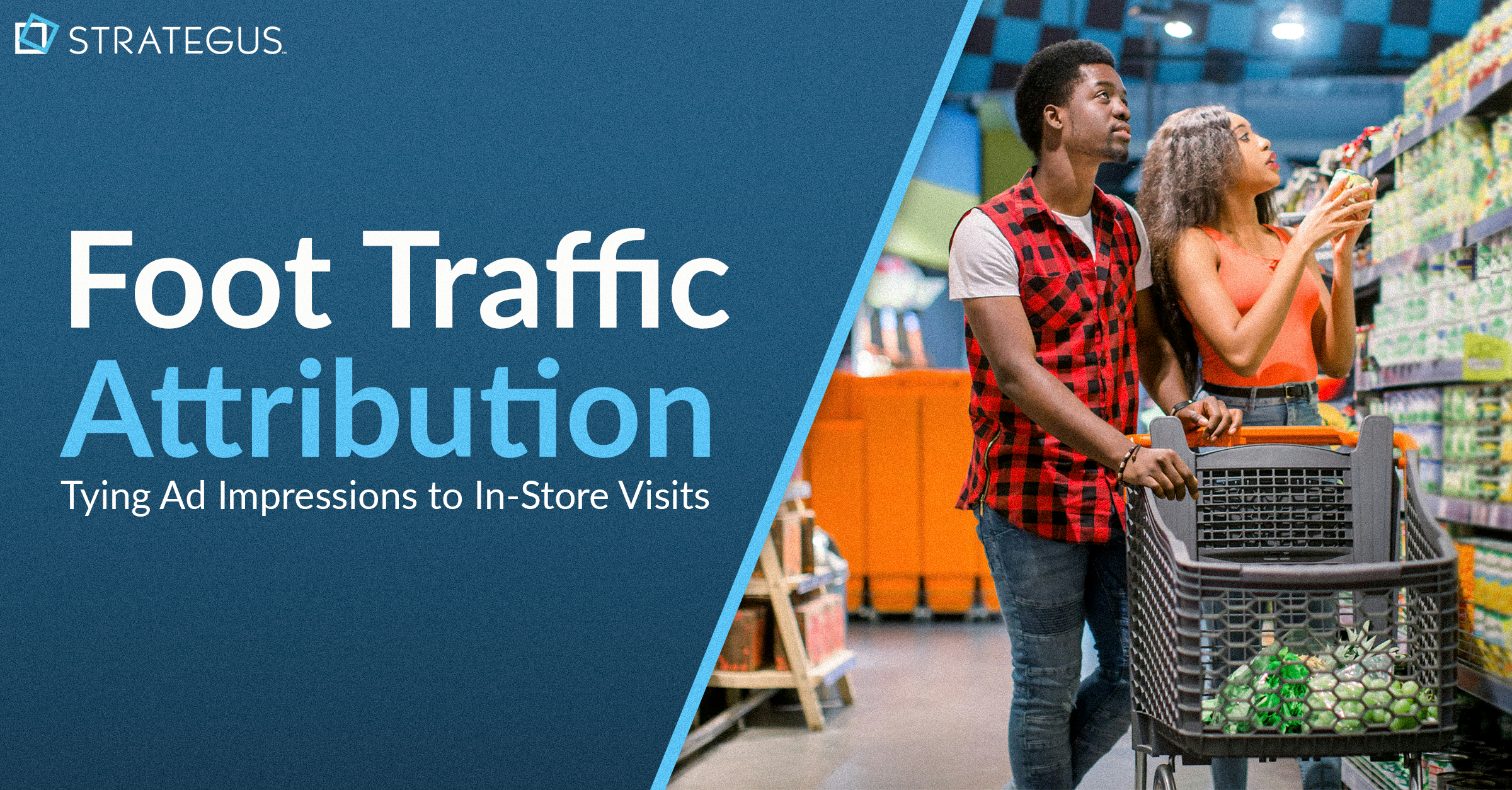- Home
- Company News
- Targeted Ads Have Come to Your TV
Targeted Ads Have Come to Your TV
 Andy Dixon
Andy Dixon
9 minutes read

People who watch the Discovery Channel, the Food Network, HGTV, Animal Planet, or a variety of other channels and streaming services may remember seeing an ad for a new brand of frozen yogurt bars. The commercial ran last year, featuring a cute young couple that loves the dessert so much they hide it from each other in a bag of frozen brussels sprouts.
If you saw that commercial, it’s probably no coincidence. The advertiser used reams of personal data to send the ad specifically to people like you. Your next-door neighbors may have been watching the same show, but if so they probably saw something else during the commercial break.
The frozen yogurt campaign was set up by a company called Strategus, one of many advertising technology firms that place targeted ads on TV. To find the perfect audience, Strategus says it bought lists of consumers who had recently purchased frozen desserts, the kind of data the company routinely sources from companies including Acxiom, Mastercard, and Nielsen. But these were healthy yogurt bars. So Strategus cross-referenced those lists with people identified by data brokers as “interested in healthy living,” based on clues like frequent trips to a yoga studio or time spent on low-carb-recipe websites.
Strategus used that data to pick the 2.26 million households where the frozen yogurt commercials played in August and September of 2020. Then it worked with data brokers and other companies in an effort to monitor the online behavior of the people who saw the ad, working to identify their phones and laptops to see how the ad influenced them. The company says that shortly after seeing the ad, 563 people went to websites related to ice cream. Another 1,256 browsed the “Find a Store” page on the dessert company’s website.
This is the same kind of targeted or "addressable" advertising and tracking that has long been ubiquitous across the web.
“We’ve become accustomed to the fact that when you go to a website, you’re going to see advertising that’s different from what someone else sees,” says Joel Cox, co-founder of Strategus. "Connected television is harnessing that same degree of targeting, specificity, and sophistication.”
You usually can’t tell you’re seeing a targeted commercial simply by watching it. They look just like the 30-second spots you’ve always seen, with jingles, cheerful actors, and cheesy dialogue. The only difference is how the ads find you, through a complex, behind-the-scenes system that trades personal data billions of times a second to find the most receptive eyes for each sales pitch.
All of this is possible because a modern television is a lot like a giant smartphone. Streaming services are basically apps, and your TV uses them to play video streams and ads aimed right at you. Just like a phone, your TV also collects data to send back to the company that built it. The manufacturer can tell exactly what you’re watching, even if you’re playing a Blu-ray disc or using an antenna. Streaming services get a lot of the same data.
“That makes your television one more piece of technology that behaves as though it doesn’t totally belong to you, even after you’ve paid for it and installed it in your home,” says Maureen Mahoney, senior policy analyst for Consumer Reports.
Obviously, a new TV you bring home shows you movies and shows. But it’s also designed to quietly extract data about you that can be sold to other companies or used for targeted ads. “It’s an old cliché in the tech world that if you’re not the customer, you’re the product,” Mahoney says. “When it comes to targeted ads on a smart TV, you’re both.”
The Pandemic Boom
The TV advertising we all grew up with was about mass-market messaging. Cable companies, TV networks, and local stations split up the rights to sell ad time during different shows, and they scheduled most commercials weeks or months in advance. It didn’t get much more sophisticated than showing different ads during "The Simpsons" than "60 Minutes," and everyone in a given region would see the same spots.
That’s changing most quickly on content that comes to you through the internet. Nearly every streaming service that features ads for other companies, including Hulu, Peacock, and YouTube TV, shows targeted commercials. You’ll see them whether you’re watching shows on a television, laptop, or tablet.
Television manufacturers also sell commercial time that can be targeted on the dedicated channels that come with your TV, such as the Roku Channel, Samsung’s TV Plus, LG Channels, and Vizio’s WatchFree+. Such commercials are also delivered by devices such as Amazon Fire TV, Chromecast, and video game systems. You may see targeted banner ads onscreen before you start watching a show, too.
These days it’s very likely that any ad you see on a streaming service is being shown to you based on information about you stored in marketing databases, says Jane Clarke, CEO and managing director of the Coalition for Innovative Media Measurement, a TV advertising trade group. “There’s a whole level of data that never existed in television,” Clarke says. And as far as the advertisers are concerned, she says, “if it’s not targeted, that’s a problem.”
It’s an old cliché in the tech world that if you’re not the customer, you’re the product. When it comes to targeted ads on a smart TV, you’re both.
MAUREEN MAHONEY, SENIOR POLICY ANALYST, CONSUMER REPORTS
The kinks haven’t all been worked out yet, however. If you watch a lot of streaming TV, you might notice two telltale signs of this kind of advertising. “One is over-frequency, where you say to yourself ‘I’ve seen that same commercial 27 times,’ often one right after another,” says Andrew Fischer, CEO of Choozle, an ad-tech company. “The other one that makes me cringe is when you see a placeholder during a commercial break that just says ‘We’ll be right back.’”
Those are both moments when the systems aren’t working right or when ad time didn’t get sold. “That’s the infancy of the technology,” Fischer says.
Targeted TV advertising wasn’t an especially popular choice for marketers until the pandemic. But then companies started scrambling to reach millions of people stuck at home watching TV. Spending on streaming service and smart TV advertising in the U.S. grew by 40.6 percent from 2019 to 2020, surpassing $9 billion last year, according to eMarketer, a market research company. That figure is expected to more than double by 2025.
The advertisers include familiar brands. The Trade Desk, a leading ad-tech company, says it ran connected TV campaigns for Hershey’s in the second half of 2020 to reach families with children and show more ads near stores with lagging Easter candy sales. A company called Origin Media says it has targeted television ads for Chef Merito brand spices to Latino households in Los Angeles and other parts of Southern California. Choozle says it helped a marketing company promote Luzerne County, Pa., as a destination to television viewers who were making travel plans as COVID-19 restrictions eased last year. (None of these advertisers responded to CR’s requests for interviews.)
Cable and satellite TV companies are also rolling out targeted commercials, but for now, most of the advertising they carry works the old-fashioned way. That may change in the near future. “Once marketers see real value from addressability, they will demand more,” says Alice Sylvester, a partner at Sequent Partners, an advertising consulting firm specializing in television.
The big cable providers have started trade groups, called Project OAR and Go Addressable, to develop their targeted advertising businesses. But neither of those groups nor the big cable companies agreed to speak to CR for this article.
For Sale, Your 'Identity Graph'
Advertisers that want to reach specific kinds of consumers—and only those consumers—can draw on vast pools of information. “We may not know your name, but we know that’s our guy,” says Joel Cox of Strategus.
These personal details are wide-ranging. Your credit card company may sell lists of your purchases. Google and Facebook can help advertisers reach you based on what your friends searched for or "liked" on social media a day before you hung out with them. Your apps might give away your sexuality or your religion, or just use location data to track where you drive during lunchtime. (Note: CR works with Google, Facebook, Acxiom, and other online technology providers for marketing purposes.)
“All these things get smashed into these ‘identity graphs’ made up of hundreds of billions and potentially even trillions of data points,” Cox says. Your identity graph makes it easy for marketing companies to figure out what to pitch to you, how to pitch it, and when.
Advertisers can call up a list of bowling fans from a company called Cross Pixel. Bluekai, a data broker run by the tech giant Oracle, has a handy list of people who work as gardeners or landscapers. Want to reach high-school dropouts who make $50,000 to $75,000 a year and use teeth-whitening products? In a couple of clicks, you can combine three lists to find those people using information from Experian, the data broker best known for generating credit scores.
As an example, last year an advertising platform called Five Tier ran a TV ad campaign for a company selling heating, ventilation, and air conditioning systems.
The company used U.S. Census Bureau data to limit the ad to neighborhoods in Georgia where the average income topped $100,000. Then Five Tier identified recent home buyers in those areas and layered in data from sources such as Zillow to restrict the ads to TVs in houses that were 20 to 30 years old, the age when central air systems typically need to be replaced. The company also used shopping data to filter out anyone who had recently bought a new AC. Ultimately, the ad reached 144,583 people.
Bidding for Your Attention
“At the center of targeting, data, and addressability is identity,” says Jason Manningham, CEO of Blockgraph, a TV advertising platform. That means recognizing who’s sitting in front of a screen, pulling up the information data brokers have collected on them, and then showing them the most valuable ad.
Let’s say a sportswear company is selling some new limited-edition sneakers, and it wants to run commercials only in households where someone spends a lot of money on shoes.
If you’ve been using the web to shop for expensive sneakers, data brokers have been linking all that activity to identifying details such as your IP address, the unique number that singles out your home network.
Your smart TV manufacturer and streaming services know your IP address, too. All the sneaker company and its advertising vendor have to do is buy a list of IP addresses belonging to sneakerheads and then send it over to one of those companies, such as Hulu. The next time anyone on that list turns on Hulu to binge on their favorite show, the streaming service can serve up the sneaker company’s ad. Targeted advertising online works the same way.
If you visit a store and then you go home, we can place an ad knowing that you just spent 50 minutes in a Best Buy.
FRANK O'BRIEN, CEO, FIVE TIER
But just because the sportswear company wants you to see the sneaker ad there’s no guarantee that’s the ad you’ll end up watching. Most digital ads get placed through automated, high-speed auctions, where advertisers bid to display their ads to consumers.
After all, we’re complex individuals: The high-powered business executive who breaks out a mountain bike on weekends can also be a jewelry-loving suburban mom. Maybe you spend a lot of money on skincare products and you’re also in the market for a luxury SUV. If Cadillac is willing to pay more than L’Oréal, you might see an ad for the 2021 Escalade. “These ads are being decided and placed on a millisecond-by-millisecond basis,” Joel Cox of Strategus says.
And the system isn’t finished with you once you see the ad. Advertising firms are eager to follow your activity afterward, both online and out in the physical world, to see how well the marketing worked, or maybe to show you a follow-up advertisement later.
“If you visit a store and then you go home, we can place an ad knowing that you just spent 50 minutes in a Best Buy,” says Frank O’Brien, CEO of Five Tier. Then "we can tell if someone saw an ad, when they saw an ad, and what they did afterward.” Five Tier attributed 2,841 heating and air conditioning service appointments and more than 4,000 visits to the HVAC company’s website to its placement of those targeted TV commercials in Georgia.
All of the data streams that enable that kind of tracking aren’t perfectly integrated yet, but ad-tech companies are working hard at it, from Google and Facebook to specialized companies such as Five Tier. In addition to TVs, phones, and computers, targeted ads and consumer tracking have even spread to digital billboards and screens at gas pumps that show different ads depending on who’s passing by.
Companies ultimately want their advertising campaigns to follow you as you shift from your phone to your TV to your car radio to the screen on a treadmill at the gym, with your web browsing, purchases, and travels in the physical world all seamlessly linked to measure how well the ads are working. Once it’s all synced up the way ad-tech companies want it, they’ll be able to turn your every move into a data point and another opportunity to turn your attention into advertising dollars.
“It’s only a matter of time,” O’Brien says. “On paper, it’s not that difficult. That’s going to be the world, hopefully for me, in a few short years.”

Andy Dixon is a seasoned Content Writing Specialist at Strategus, renowned for his expertise in creating engaging and impactful digital content. With over a decade of experience in content creation, Andy has honed his skills in a variety of niches, ranging from technology and marketing to education.
Strategus is a managed services connected TV(CTV) advertising agency with over 60,000+ campaigns delivered. Find out how our experts can extend your team and drive the result that matter most.
Talk to an Expert
Seeking a Custom CTV Strategy That Delivers?
What to read next

Todd Porch Named to the 2025 Colorado Titan 100
Denver, CO – March 18, 2025 – Titan CEO and headline sponsor Wipfli LLP are pleased to announce Todd Porch, CEO of Strategus, as a 2025 Colorado...
3 minutes read

Strategus Announces Majority Investment from Private Equity Firm CIVC Partners
Investment will fuel continued growth of leading managed services provider of CTV advertising Todd Porch moves from President to CEO as company is...
3 minutes read

Strategus Named To Denver Business Journal Fast 50
DENVER – September 25, 2020 – The Denver Business Journal has named Strategus to its 2024 Fast 50 list of fastest-growing private companies in...
2 minutes read

Strategus Secures Access to Netflix Ad Inventory
At Strategus, we’re always looking for ways to help our clients stay ahead of the curve, and we’re excited to announce that Netflix advertising is...
1 minutes read















